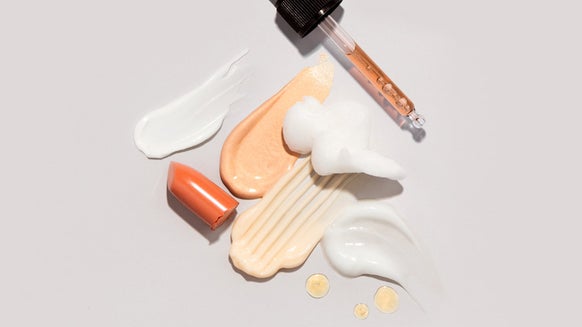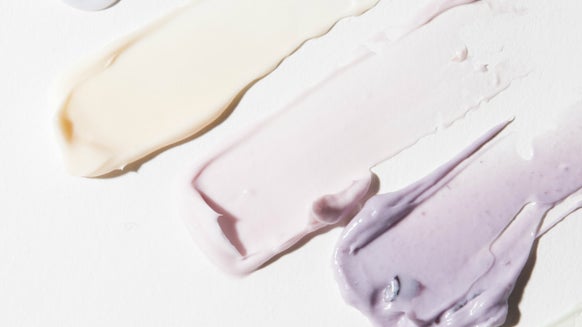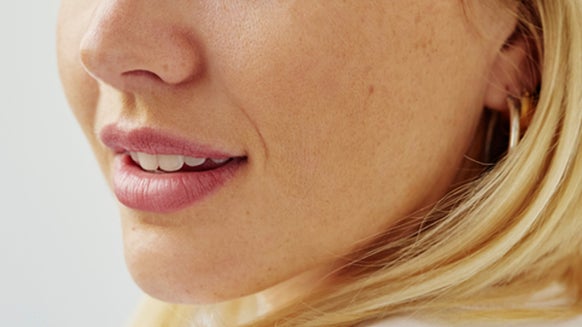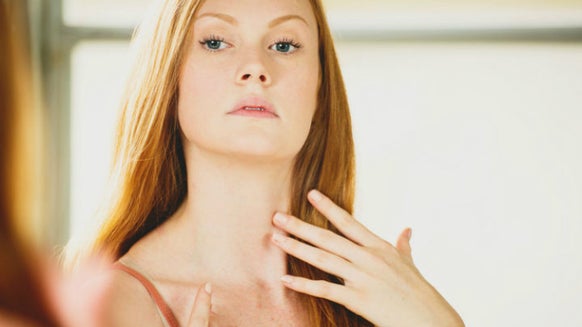17 Most Common Labels on Your Beauty Products (and What They Really Mean)
Whether you're in the market for a new cleanser or moisturizer, looking at the label—or product information—is one of the most important steps to selecting the right beauty product for you. Not only can a label tell you what the product is (SPF, serum, eye cream) and who it’s formulated for (anti-aging, dry skin, acne-prone), it can also give you more insight into how the formula came to be and if it is eco-friendly, organic, cruelty-free or vegan.
Need help decoding the labels on your beauty products? We break down the top logos, words, phrases and ingredients.
1. Natural
When it comes to natural beauty products, not all ingredients have to be natural. “As long as a few ingredients that are listed are natural, the product can be labeled as natural,” says board-certified dermatologist, Debra Jaliman. “If a product is labeled as ‘natural’ it will generally mean that at least some natural ingredients have been used in the formula, but a product can be labeled as natural and contain up to 30% synthetic ingredients,” she adds. “If you are looking for a product that is completely natural, make sure it’s labeled 100% natural. [This] means there are absolutely no synthetic ingredients.”
In addition, 100% natural products might also include a certified logo, such as one from the Natural Product Association (NPA).
2. Clean
“Clean” is a word that is frequently used to describe a type of beauty product that is made without ingredients that are potentially harmful or irritating. As a bonus, it also includes products that aren’t tested on animals, says Cosmetic Dermatologist, Dr. Michele Green. That said, you’ll want to proceed with caution as “there are no government agencies that regulate clean skincare like the food industry,” explains Dr. Green. “In beauty, the Environmental Working Group (EWG) is the closest thing there is to the USDA,” she adds, noting that the EWG has a process that companies go through to get their products certified.
According to Dr. Green, the words “clean” and “natural” are often used interchangeably, but they are two different things. “Clean means the product will not cause any harm or irritation to the body [and] can include natural as well as synthetic ingredients,” she explains. “Natural, however, means the ingredients are not chemically produced and have no synthetic additives.”
3. Hypoallergenic
If you have sensitive skin, look for skin care and makeup products that are labeled hypoallergenic, as they are less likely to cause allergic reactions. That said, if your skin is prone to allergic reactions, you’ll want to test the product out on the inside of your wrist or consult a dermatologist before applying it to your face, as the term “hypoallergenic” is not regulated by the FDA and does not guarantee you won’t experience an adverse reaction.
4. Non-Comedogenic
For those who have oily skin or are prone to breakouts, look for a product that is non-comedogenic. “Anyone who is acne-prone should use non-comedogenic products,” says Dr. Jaliman. “It means that the product does not contain ingredients that are known to clog up the pores, which increases the chances of getting acne,” she adds. Non-comedogenic products come in a variety of formulas, including ones you wouldn’t think possible, like facial oils and sunscreens.
5. Parfum
If you take a look at your perfume collection, you may notice the word “parfum” written on the label. Simply put, parfum is French for perfume or fragrance. Because the FDA does not require cosmetic companies to individually disclose each fragrance, parfum or fragrance can stand for a variety of fragrant ingredients, both synthetic and natural.
6. Natural Fragrances
So, how do you tell if your parfum (or skin care, hair care and makeup) is formulated with naturally derived fragrances? Check the ingredients label. “Products that say they contain natural fragrances are constructed with natural, raw materials like isolates. Isolates are substances that have been naturally isolated from a botanical, also known as essential oils,” says Dr. Jaliman.
According to Dr. Jaliman, one of the biggest difference between synthetic and natural fragrances is that “synthetic fragrances last longer than natural fragrances. Natural fragrances fade quickly because they lack the non-synthetic components, which makes a scent more vibrant and last longer,” she explains.
7. Fragrance-Free
For those who are sensitive to fragrance, products with a fragrance-free certification or Safer Choice logo are a must. “Added fragrances can cause allergies,” says Dr. Jaliman. “Choose products that don’t include fragrance as part of the [ingredient] list,” she adds. According to the EPA, a fragrance-free product cannot include any fragrance, including the chemicals used to mask a scent.
8. Unscented
Just because a product is unscented doesn’t mean it doesn’t contain fragrance. If that were true, it would just be called (and certified) fragrance-free. Unlike fragrance-free products, unscented formulas may contain chemicals used to mask scents, making them scent-free, but not fragrance-free. Unscented products are ideal for those who are not sensitive to fragrance, but prefer a formula that doesn’t have a scent.
9. Sulfate-Free
Another phrase to look out for? Sulfate-free. “Sulfates are aggressive detergents (commonly used in shampoos) made of sulfur-containing mineral salts,” says Dr. Jaliman. “We don’t want them in products because they are harsh and can cause irritation on [the] scalp or other areas,” she notes.
Sulfates aren’t the only ingredients to be wary of. Phthalates can be harmful, too. “Phthalates are a group of chemicals used in hundreds of products, such as soaps, shampoos and lotions,” says Dr. Jaliman. “There are different types of phthalates, [but] the one still most commonly used in cosmetics is DEP,” she adds. “They are used in personal care products to moisturize and soften skin and to aid in dissolving certain ingredients. [This] can damage the liver, kidneys and reproductive system,” she explains.
11. Paraben-Free
If you look on the back of your beauty product label, you may notice the words “paraben-free.” But, what are parabens and why should we be cautious of them? “Parabens are used as preservatives in cosmetic products,” says Dr. Jaliman. They are used to prevent the growth of bacteria, [but] have been known as estrogen disruptors [and] have been linked to breast cancer and reproductive issues,” she adds.
12. Broad-Spectrum
Shopping for sunscreen? Make sure to select a sunscreen formulated with broad-spectrum SPF. “A broad-spectrum sunscreen protects you from both UVA and UVB rays,” says Dr. Jaliman. UVA rays can prematurely age your skin, causing wrinkles and hyperpigmentation, [while] UVB rays can burn your skin,” she adds. “You need broad-spectrum SPF because you want protection from all UV light—too much exposure to [both] rays may lead to cancer,” she warns.
13. Vegan
Just because a product has a certified cruelty-free logo printed on its label doesn’t mean it’s vegan. For a vegan skin care or beauty product you can trust, Dr. Jaliman says to look for the Vegan Action or Vegan Awareness Foundation logo. Both of these logos certify that a product is formulated with vegan ingredients. In addition, Dr. Jaliman adds, “For a product to be considered vegan, it must not contain animal products or by-products [and] must not be tested on animals.”
14. Certified Organic/USDA Organic
Just like cruelty-free and vegan products, organic products also need to be legitimized by a special certification. For products formulated with organic ingredients, look for the certified organic or USDA organic symbol on the product label. That said, don’t be fooled by marketing. If you see the word “organic” and no certification on a label, it might not be organic. “In order for a product to be considered ‘certified organic,’ the item must be 95% or higher free of synthetic additives like pesticides, chemical fertilizers and dyes,” explains Dr. Jaliman.
15. Ecocert
Another certification logo to look out for? Ecocert. “If a product has an ecocert logo, it means it has been inspected by one of the highest respected organizations that determine if a product is organic,” says Dr. Jaliman. “Ecocert is an organic certification organization based in Europe, but conducts inspections in over 80 countries,” she adds. “It is one of the largest organic certification organizations in the world.”
16. PAO
The PAO symbol—or, period-after-opening symbol—is another important logo to look out for. It looks like a small jar of body butter with a number and the letter “M” written inside or underneath it. The number represents a product’s expiration date once opened for the first time. For example: If you open a product labeled “6M,” you have 6 months to use it before it’s considered expired.
17. Cruelty-Free or Leaping Bunny
If you’re looking for a skin care or beauty product that is certified cruelty-free, check the label for a Leaping Bunny logo, issued by Cruelty Free International. According to Dr. Jaliman, “If a product has a bunny on it, it means it has not been tested on animals.” If your beauty product has a Leaping Bunny logo on it, it also means that it’s globally recognized as cruelty-free and has gone through a variety of rigorous testing (which includes independent audits by Cruelty Free International). According to the organization, this is to ensure transparency between the brand and consumer, as brands often include cruelty-free jargon (and can go as far as to include a variation of a bunny logo) on the packaging without certification, causing confusion. To be sure your cruelty-free product is legit, check the label for the specific Leaping Bunny logo associated with Cruelty Free International.
What Else You Need to Know
In addition to understanding the words and phrases used on beauty product labels, you may also want to take a look at the ingredients list. “This is essential, especially if you’re someone with sensitive skin,” says Dr. Jaliman. “Someone who has sensitive skin can experience inflammation and irritation if they choose a product with harsh ingredients for their skin type,” she adds. “It’s important to choose the right skin care for sensitive types because some products contain ingredients that can cause an adverse reaction.” Furthermore, Dr. Jaliman says, “People with rosacea, eczema or allergies should pay close attention to the ingredients in their products.”
Another reason to read the ingredients list? It can help you get a better sense of where the formula (and its ingredients) were before being bottled up and placed on the shelf. “Having too many ingredients listed may be a bad thing [because] the more ingredients a product has, the more likely the product or its ingredients have been tested on animals,” she adds. If this is something you’re concerned about, shop for products with the Leaping Bunny logo (mentioned above) and consider purchasing vegan beauty products.
Lastly, the ingredients list can tell a formula’s unique story and help you better determine if the product is right for you. “You can tell which ingredients have higher concentrations because ingredients are listed in order from greatest to least amount,” explains Dr. Jaliman. “One should pay attention to this because ingredients can be listed low on the list (meaning lowest concentration), [but] may be irritating even in very small amounts,” she adds. If you have never heard of an ingredient before and are concerned about what it is and the effect that it might have on your skin, Dr. Jaliman suggests researching the specific ingredient online or consulting a dermatologist before applying it to your skin.

From the latest hair and makeup trends to the best solutions for your skin issues, we've got all your beauty concerns covered!







